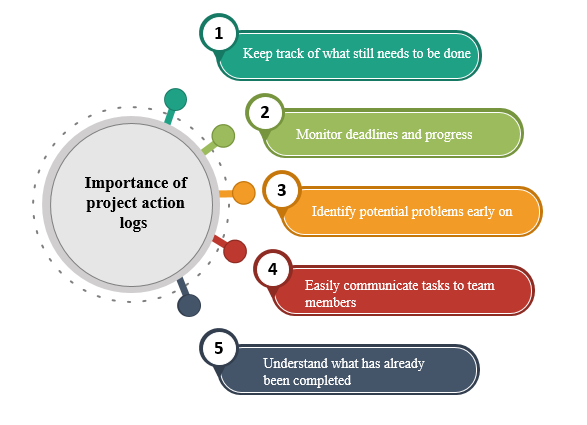Project Action Log
A project action log is a document that lists all of the tasks that need to be done to complete a project. It can be helpful to keep this list in a central location so that everyone working on the project can easily see it and add their tasks. This can avoid duplication of work and help ensure that all tasks are completed on time. A project action log is an essential document that should be kept up to date for every project. The record can help track the project's progress, what tasks have been completed, who completed them, what problems were encountered, and how they were solved. This information can be beneficial in assessing how well the project is going and whether it is on track to meet its goals. The project action log is created by the project manager, who is responsible for ensuring that all tasks and activities associated with the project are tracked and recorded.

Types of Action Logs:
Actions logs are an essential part of any system that relies on input from users. By tracking the actions taken by a user, you can get a sense of how they interact with your system, where they have problems, and what features they like or don't like. There are four main types of action logs:
- User Feedback Logs: This track every interaction a user has with your system, usually including what page or screen they were on, what action they took, and what came out of it.
- Error Logs: This tracks any errors that occur, often listing the page or screen where the error happened, the type of error, and any other relevant information.
- Usage Logs: These track how often a particular action is taken, usually by recording the date and time it was done.
- Feedback Collection Forms: These track what users say about their experience with your system, collecting data like what they liked or didn't like, what confused them, what frustrated them, and so on.
Importance of Project Action Logs:
Creating and maintaining an action log is a crucial step in project management. By tracking all actions – both big and small – you can ensure that nothing falls through the cracks, that everyone on the team is kept in the loop, and that the project moves forward as efficiently as possible. A practical action log will help you to:
- Keep track of what still needs to be done.
- Monitor deadlines and progress.
- Identify potential problems early on.
- Easily communicate tasks to team members.
- Understand what has already been completed.

Elements of action item :
- Tracking Number and Title: The most straightforward identifier for the action item is its name. Keep the title short because you'll write a description later and fill in the information. In addition, it's a good idea to provide each item with a tracking number. This will make it easier to track and report on them, especially if you have a lot of them at once.
- To determine what to focus on first when dealing with several action items, assign each one a priority. Not all of them must be completed in the sequence they were given. Naturally, some will be more pressing than others.
- Date of Creation and Expected Finish: When establishing action items, keep three dates: the creation date, the expected completion date, and the completion date. It should be noted that not all will be completed, and some may be "resolved." These items have become obsolete over time and do not require completion.
- Creator and Assignee: Who created the action item and who they assigned it to are listed here. This allows everyone involved to know where to target their questions. This is essentially a method of accelerating communication.
How To Write Practical Action Items?
When you're tasked with writing an action item, the goal is to create a tangible and measurable outcome that a specific individual or team can accomplish. Follow these four steps to make sure your action items are practical:
- Clearly define the objective. What needs to be done?
- Assign responsibility. Who will do what?
- Establish a timeline. When will it be done?
- Set a priority level. How important is it?
Best Practices To Keep In Mind While Creating Action Logs:
- Action logs can be a precious tool for goal setting and productivity. By writing down everything you do daily, you can better understand where your time is going and identify areas for improvement. However, there are a few things to keep in mind when using action logs.
- Be realistic about the time you have - When creating your action log, be honest about the time you realistically have for each task. Don't try to fit too much into one day.
- Keep it short and sweet - If you find your action log becoming overwhelming, try to simplify it. Break down each task into minor possible steps.
- Don't forget to celebrate your successes - As you work through your activity log, celebrate any accomplishments or progress made towards your goals.
- Consider resources - Consider the essential resources, such as budget, labor, and time, when designing an action item. These resources could impact who you allocate them to and what else you assign them.




